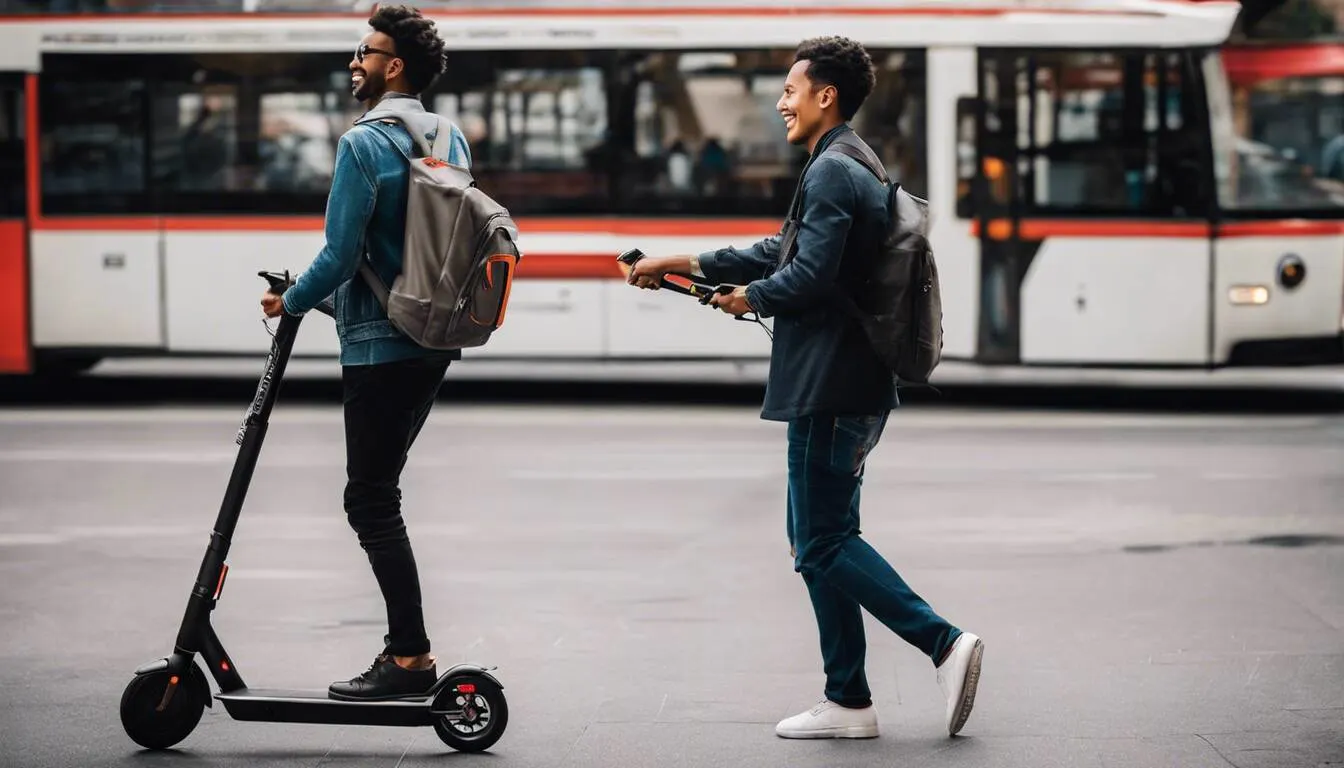Ever wondered how to combine the thrill of scooting and the convenience of bus travel? Let’s break down the barriers and unshackle those wheels! As urban mobility evolves, so does our need for clarity on public transportation policies. Navigate this not-always-so-clear pathway as we dive into whether you can bring a scooter onto a bus – a question that often leaves many scratching their heads. From compact mini-scooters to robust electric ones, your epic bus journey with a faithful two-wheeled companion begins here! So, buckle up and keep scrolling as we demystify transportation guidelines and rules like never before!
Yes, in most cases, you can bring a scooter on a bus. However, it is important to check the specific rules and regulations of the local transportation authority or bus service provider. Generally, foldable scooters are preferred as they are more convenient for public transit. Make sure your scooter meets size and weight limitations, is placed in the designated wheelchair space, and adheres to any other local regulations or guidelines. It is also advisable to switch off the battery-powered mode for safety reasons.

Table of Contents
Is it Permissible to Bring a Scooter on a Bus?
Riding a scooter is a convenient way of commuting. However, there may be circumstances where one needs to hop on public transportation with their scooter. If this is the case, can you really bring your scooter onto the bus? The answer isn’t straightforward, as guidelines vary between different transport systems and regions.
Some public transportation services allow riders to board buses with scooters as long as they are foldable and can fit into an allocated storage area. Other services adopt more lenient policies that allow small electric scooters with compact dimensions aboard buses or trains. Meanwhile, other transport services forbid any type of personal mobility aids, including bicycles and scooters.
To ensure you don’t violate any regulations, it’s vital to familiarize yourself with the transit system’s rules before boarding with your scooter.
Public Transit Rules and Regulations
Each transit system has its set of rules relating to scooters and other personal mobility devices. For example, the Americans with Disabilities Act (ADA) requires transportation providers to offer equal access for people with physical disabilities, including accommodating certain types of mobility assistive devices such as scooters [1].
Transport systems may have different specifications regarding the size, weight, or type of scooter that’s permissible on board. Generally, foldable non-motorized scooters are allowed on buses if they meet specific size requirements and can be stored in designated areas [2]. Some scooters may also be permitted on trains depending on several factors, such as weight limits and dimensions.
It’s essential to note that motorized or electric-powered scooters may attract stricter regulations than non-motorized ones. For instance, some transport systems require that electric-powered devices have batteries below particular electrical voltage levels for safety reasons [3]. These regulations aim to ensure passengers’ safety during transit while minimizing the risk of accidents caused by short circuits or battery explosions.
To put this into perspective, think of public transit rules as guidelines to follow like traffic laws. Just as you would adhere to traffic signals and road signs while driving a car, it’s essential to familiarize yourself with public transit regulations before boarding with your scooter.
REFERENCES: U.S. Department of Transportation. (2015). ADA Requirements for Over-the-Road Buses — A Guide for Drivers, Revisors, and Users. Metropolitan Transit Authority of Harris County. (2018). Riding the Bus or Rail System. Transit Safety Board of Canada. (2020). Guidelines for Electric Mobility Devices on Public Transit Buses.
Storage Areas on a Bus for Scooters
Transportation in the US varies depending on your location, and it can get confusing at times, especially when you’re traveling with unique items like a scooter. If you’re a regular rider, you’ll be aware that several transit agencies have considered electric or manual scooters as acceptable baggage on buses. However, each transit agency has its own rules regarding scooter dimensions and weight limits.
Ideally, RTA buses need to maintain adequate space for riders who use mobility-assisting devices such as wheelchairs or other mobility aids. Due to this reason, storage areas for scooters are usually limited and can accommodate one scooter at a time. But the good news is that most transit systems offer free storage for users’ scooters in the same manner as bicycles, so long as you follow specific guidelines prescribed by these transport systems.
Riverside Transit Agency reserves bike racks primarily for bicycles, and there’s only one rack per bus that accommodates up to three bicycles or scooters. If your scooter is foldable and small enough to fit under the seat on board the bus without encroaching into another rider’s space, then that is an excellent option.
The general rule of thumb is ensuring your electric or non-electric scooter does not exceed more than 55lbs/meters in weight and does not hinder free movement inside the bus to avoid obstructing other passengers’ path.
Moving on from storage considerations let’s look at things to consider when packing your scooter for bus travel.
Scooter Considerations for Bus Travel
When traveling with a scooter on a bus, it’s essential to pay close attention to some guiding principles that ensure both you and others’ safety while giving you peace of mind throughout your journey.
One fundamental consideration is determining whether the scooter folds or does not fold; non-folding scooters need extra care in selecting an area with adequate space while on the bus. Electric scooters, which feature a removable battery, must ensure it’s disengaged and carried separately while riding on the bus.
It’s essential to prepare adequately for bus travel with your scooter, as some considerations include removing all accessors- ensuring there are no loose items that can cause damage during transport.
Think of traveling on a bus with your scooter like preparing for a long journey- where you need to pack correctly and anticipate any hurdles along the way.
Suppose you have a basket attached to your scooter; removing it and other accessories before boarding is necessary as it frees up space for other passengers’ scooters or bicycles.
Before setting out, check both federal laws around scooter transportation and your local/state transport agency guidelines. It ensures that you are well aware of the rules guiding scooter transportation and plan accordingly – avoiding unnecessary issues while commuting.
Now that we’ve explored considerations when packing and traveling with your scooter let’s look at foldable vs non-foldable scooters as this would determine if you might require additional storage options on board the bus.
Foldable vs Non-foldable Scooters
If you are a scooter owner and use public transportation, it’s crucial to understand the difference between foldable scooters and non-foldable ones. Some transportation service providers may not allow non-foldable scooters on board due to their bulkiness and weight. On the other hand, foldable scooters usually have more of an advantage since they can be easily stored in a compact manner that occupies less space.
For instance, if you plan on commuting using buses or subways, possessing a foldable scooter would work out best. You could quickly disassemble parts, such as removing the handlebar with an Allen key – making it compact enough to fit into a backpack.
Besides, many states have varying laws regarding non-foldable scooters in public transport systems. It’s vital to research your city’s specific regulations beforehand to avoid non-compliance scenarios.
Accessibility for Passengers with Disabilities
Public transport systems must ensure ease of accessibility for everyone – including passengers with disabilities. Therefore, when boarding a bus or subway ride with a scooter as a person with accessibility needs, there are several rules you should be aware of.
Firstly, some buses allow mobility devices and wheelchairs only up to certain weight limits. If your scooter exceeds these stipulations, the driver might request you disembark and take another form of transportation suitable for your device.
Moreover, some buses feature folding seats that can be flipped up so that mobility devices have adequate space while on board. These particular seats provide additional floor-space customarily reserved for strollers or large mobility devices.
It is essential to remember that under federal law:
- Buses must be able to accommodate captain’s chairs (commonly used as seating on motorized wheelchairs)
- Strollers on buses must not exceed 30 inches long and 48 inches tall when fully deployed
- Service animals accompanying disabled riders are permitted on buses, even if there is a “no pets” policy
Adhering to scooter accessibility rules tailored for people with disabilities is an absolute necessity. However, many bus services have general restrictions regarding scooter transport that are independent of disability considerations.
See Related: Can You Bring an Electric Scooter on the Bus? Rules and Regulations Explained
Restrictions for Scooters on Buses
If you’re considering bringing a mobility scooter on a bus, it’s essential to familiarize yourself with any restrictions before doing so. While most countries allow the transportation of mobility scooters on buses, there are specific guidelines and rules that users must adhere to as they vary for different countries and states. Restrictions are generally put in place to ensure the safety of passengers and drivers while also complying with legal requirements. Mobility scooter users need to consider the size of their device, its weight, and any storage or equipment needs.
For example, many bus companies require that mobility scooters do not exceed dimensions of 30 inches by 48 inches and have a maximum weight limit of 600 pounds, including the rider’s weight. Some buses may not permit the scooter to move while inside; thus, users must shift from their mobility scooters onto bus seats or designated spaces before boarding.
Below are some additional general restrictions concerning mobility scooters on buses:
| Country/State | Restrictions |
|---|---|
| The United States | Scooter must not weigh over 600lbs (including the rider), width & length should be no more than 30”x 48”, mobility scooters should have secure fastenings during transport and no part of the scooter should protrude outside of the confines of seat space |
| United Kingdom | Prohibition of “Class A” mobility devices since they are considered too large for public transport usage |
| Australia | Buses may carry at most two types: either push-frame wheelchairs or front-wheel power-assist chairs. For compatibility purposes, rigid-frame push wheelchairs cannot be accommodated by low-floor vehicles |
It is important to note that there may exist additional limitations depending on local transit authority regulations or regional laws. It is advisable for riders always to check with local public transit authorities before attempting to take their mobility scooters on buses. For safety reasons, on buses that allow for the transportation of mobility scooters, it is essential that each user follows these guidelines and all others provided by the transit system.
It is best to ensure that you remain within your local or state guidelines to have no issue when boarding a bus with your mobility scooter. Familiarizing yourself with restrictions beforehand will save you time and prevent avoidable transport challenges. It would also be smart to leave plenty of extra time for the driver and assistants to help make sure transfers are safe, smooth, and secure for everyone involved.
